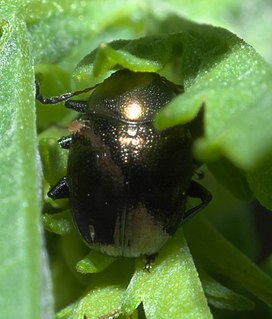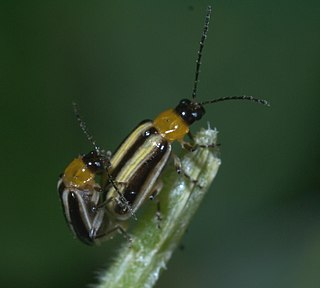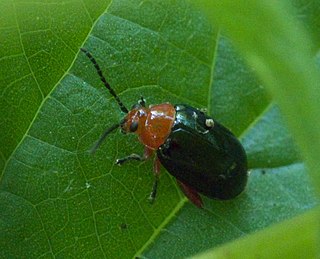
The flea beetle is a small, jumping beetle of the leaf beetle family (Chrysomelidae), that makes up the tribe Alticini which is part of the subfamily Galerucinae. Historically the flea beetles were classified as their own subfamily.

Colaspis is a genus of leaf beetles in the subfamily Eumolpinae. It is one of the largest genera in the subfamily, containing over 200 species, and it is known from both North and South America. A number of species from this genus are considered to be pests, such as the grape colaspis. Some species are known from the fossil record from the Eocene of Colorado in the United States.

Calligrapha is a genus of large American Chrysomelinae of imprecise taxonomic boundaries. Most species occur in Central and South America.
Colaspoides is a genus of leaf beetles in the subfamily Eumolpinae. It is one of the largest genera in the subfamily, containing over 260 species worldwide. It is an extant genus but there is at least one species, C. eocenicus, found in Baltic amber from the Upper Eocene of Russia, and the genus has also been reported from the Miocene of the Dominican Republic.

Brachypnoea is a genus of leaf beetles in the subfamily Eumolpinae. It is mostly found in the Neotropical realm, though there are also eight known species in the Nearctic realm.

Eumolpini is a tribe of leaf beetles in the subfamily Eumolpinae. It is the largest tribe in the subfamily, with approximately 170 genera found worldwide. Members of the tribe almost always have a longitudinal median groove on the pygidium, which possibly helps to keep the elytra locked at rest. They also generally have a subglabrous body, as well as appendiculate pretarsal claws.

Luperini is a tribe of skeletonizing leaf beetles in the family Chrysomelidae. There are more than 30 genera and 500 described species in Luperini.

Rhabdopterus is a genus of leaf beetles in the subfamily Eumolpinae. There are about 70 described species in Rhabdopterus from North and South America, eight of which are found north of Mexico. The Nearctic species may not be congeneric with the type species, which is South American.
Acallepitrix is a genus of flea beetles in the family Chrysomelidae. There are more than 20 described species in Acallepitrix. They are found in the Neotropics, Central America, and North America.
Chrysodinopsis is a genus of leaf beetles in the subfamily Eumolpinae. It was first described by the Czech entomologist Jan Bechyné in 1950. There are three described species in Chrysodinopsis. The genus is possibly synonymous with Brachypnoea.
Spintherophyta is a genus of leaf beetles in the subfamily Eumolpinae. Most species in the genus are found in Central and South America, but there are also a few North American species.

Asphaera is a genus of flea beetles in the family Chrysomelidae, containing some 130 species, found in North America, Central America, and the Neotropics.

Typophorini is a tribe of leaf beetles in the subfamily Eumolpinae. The tribe contains approximately 100 genera, which are found worldwide. Members of the tribe are mainly characterized by notches on the tibiae of the middle and hind legs, which are sometimes referred to as antenna cleaners. They also generally have a subglabrous body, as well as bifid pretarsal claws.
Alethaxius is a genus of leaf beetles in the subfamily Eumolpinae. It is distributed from Mexico to northern South America, and it is also found in the West Indies. The genus was originally named Aletes by Félicien Chapuis in 1874. However, this name was preoccupied by Aletes Carpenter, 1857, so the genus was renamed to Alethaxius by Édouard Lefèvre in 1885. According to Flowers (1996), it is very likely that Alethaxius is polyphyletic and represents at least three different genera.
Allocolaspis is a genus of leaf beetles in the subfamily Eumolpinae.

Bromiini is a tribe of leaf beetles in the subfamily Eumolpinae. The tribe contains approximately 120 genera, which are found worldwide. They are generally thought to be an artificial group, often with a subcylindrical prothorax without lateral ridges and covered with setae or scales.
Notozona is a genus of flea beetles belonging to the family Chrysomelidae. The 22 species of this genus are found in Central and Southern America. The genus is closely related to Blepharida.

Podontia is a genus of flea beetles in the family Chrysomelidae. They belong in the Blepharida-group of flea beetles.









